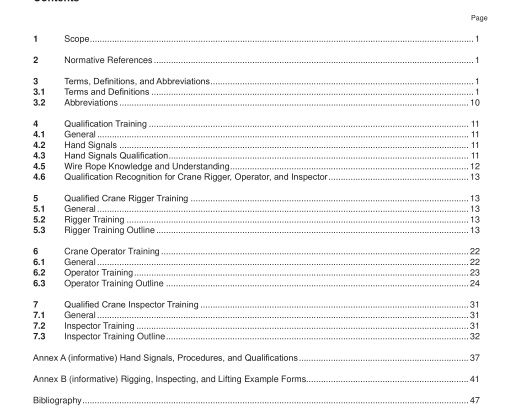API 2D-2:2020 pdf free download.Training for Ofshore Pedestal- Mounted Crane Riggers, Operators, and Inspectors
2) sling application (confguration and function),
3) sling inspection/rejection criteria,
4) sling handling and storage,
5) sling angle and load tension,
6) D/d ratio, and
7) cargo nets and other basket types (e.g. bulk bags/fexible fabric).
b) Describe confgurations to include diferent types of hitches (vertical, choker, basket).
c) Describe function, applications, and safety precautions of hitches (vertical, choker, basket).
d) Describe when to use and how to use.
e) Describe the efect of the sling load at diferent sling angles.
f) Describe safe and proper storage techniques/practices for all rigging hardware.
5.3.1.3 Including and in addition to those items listed in 5.3.1 .1 and 5.3.1 .2, the course content and appropriate section objectives shall also include discussion on the following topics related to procedures and precautions.
a) Procedures and precautions:
1 ) load control/taglines,
2) unbinding loads,
3) personnel transfer/pre-lift considerations,
4) sling handling and storage,
5) determining load weights and center of gravity of load,
6) softeners (e.g. wear pads),
7) attaching unused sling legs,
8) improving sling efciency,
9) turning loads,
1 0) securing loads, and
11 ) placement of loads.
b) Describe the procedures and inspection for each type of personnel transfer equipment.
5.3.1.4 Including and in addition to those items listed in 5.3.1 .1 through 5.3.1 .3, the course content and appropriate section objectives shall also include discussion on the following topics related to procedures and recautions.
a) Pinch points/body positions.
b) Personal protective equipment (PPE).
c) Hand signals/radio communications.
5.3.2 Practical Exercises
5.3.2.1 General
The examiner shall mentor or coach the student until they have satisfactorily passed to ensure acceptable understanding and responsibility.
Training shall document and ensure that practical exercises include the following.
a) A crane should be used during these exercises.
b) Actual hardware typically used on the job.
c) Minimum of one practical exercise for each student on each appropriate topic item as follows:
1 ) rigging hardware,
2) slings,
3) procedures and precaution, and
4) rigging basics.
NOTE Follow the manufacturer’s recommendations on inspection, maintenance, installation, and identifcation.
d) The minimum practical exercises are as follows:
1 ) pre-lift rigging inspection,
2) rigging hitches,
3) hand signals.
5.3.2.2 Task 1—Pre-lift Rigging Hardware and Sling Inspection Practical Exercise
5.3.2.2.1 The objective of the pre-lift rigging inspection is to test the student’s ability to understand and perform inspection of rigging hardware that is intended to be used, such as but not limited to:
— wire rope slings,
— synthetic sling,
— shackle,
— hook and latch, and
— load block.
NOTE See Annex B, Figure B.1 for an example form.
5.3.2.2.2 At the examiner’s indication to start, the student shall perform a visual inspection identifying the criteria for removal for each of the following.
a) Visually check the wire rope sling for the following:
1 ) wear,
2) abrasion,
3) broken wires,
4) corrosion,
5) kinks,
6) eye deformation,
7) end ftting condition, and
8) identifcation tag.
b) Visually check the synthetic sling for the following:
1 ) wear,
2) broken stitches,
3) heat damage,
4) chemical damage,
5) holes,
6) tears,
7) cuts,
8) snags,
9) ultraviolet (sun) damage,
10) eye ftting condition, and
11) identifcation label.
c) Visually check shackle for the following:
1 ) wear on bow,
2) wear on pin,
3) pin fush w/shackle,
4) throat opening,
5) cracks and nicks,
6) any modifcations,
7) missing parts, and
8) markings.
d) Visually check hook and latch for the following:
1 ) wear,
2) cracks or nicks,
3) latch (positive locking for personnel transfer),
4) throat opening,
5) bent tip,
6) any modifcation,
7) parts missing, and
8) markings.
e) Visually check block for the following:
1 ) wear of pins,
2) trunnion,
3) swivel clearance,
4) sheave condition, and
5) identifcation label,
6) side and cheek plates fasteners are tight.
5.3.2.2.3 The examiner shall review the test results of the practical and ensure the student has an acceptable understanding.
5.3.2.2.4 The examiner and student shall sign the practical exercise form. The student signing on the practical exercise form validates they have an acceptable understanding and knows their responsibilities.
5.3.2.3 Task 2—Rigging Hitches Practical Exercise
5.3.2.3.1 The objective of the rigging hitches is to test the student’s ability to understand and perform the basic hitches to be used:
— vertical hitch,
— choker hitch,
— basket hitch, and
— two- and/or four-part bridle sling. (e.g. ≥ 60°).API 2D-2 pdf download.API 2D-2:2020 pdf free download
